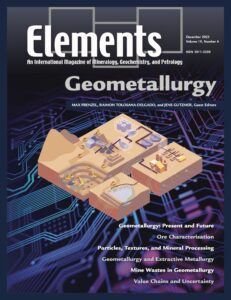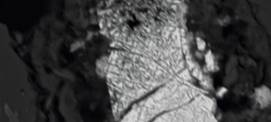Geometallurgy
Max Frenzel, Raimon Tolosana-Delgado, and Jens Gutzmer – Guest Editors
Table of Contents
Geometallurgy is an interdisciplinary research field concerned with the planning, monitoring, and optimization of mineral resource extraction and processing. Geometallurgy requires a quantitative understanding of primary resource characteristics such as mineralogical composition and texture, the distribution and variability of these characteristics across the target ore body, and how these interact with mining and beneficiation processes. This requires accurate analytical data for resource characterization, a detailed understanding of ore body geology, process technology, economics, and the oftencomplex interactions between them. In this issue of Elements, we explore the fundamental concepts relevant to the field. We also review how current geometallurgical research is opening up opportunities for geoscientists to generate better economic and environmental outcomes for the global raw materials industry as part of a sustainable economy.
- Geometallurgy: Present and Future
- Characterization of Ore Properties for Geometallurgy
- All About Particles: Modelling Particle Behaviour in Mineral Processing
- Fire and Water: Geometallurgy and Extractive Metallurgy
- Action Versus Reaction: How Geometallurgy Can Improve Mine Waste Management Across the Life-Of-Mine
- Uncertainty and Value: Optimising Geometallurgical Performance Along the Mining Value Chain
EXTRATERRESTRIAL ORGANIC MATTER
Guest Editors: Mehmet Yesiltas (Kirklareli University, Turkey) and Yoko Kebukawa (Tokyo Institute of Technology, Japan)
Extraterrestrial organic matter is found in various extraterrestrial environments and in various forms. It forms in a variety of locations through different mechanisms in space. As such, its nature, distribution, formation mechanisms and locations are of particular interest. Some organic molecules are even considered as key players for the emergence of life on Earth and possibly beyond. Therefore, their detection and characterization can contribute to the understanding of the early solar system evolution as well as the origin of life. Despite decades of work and research, there are still many questions and unknowns on this topic. The aim of this issue of Elements is to offer an overview of the concept of extraterrestrial organic matter as well as the latest scientific findings.
- Extraterrestrial Organic Matter: An Introduction Mehmet Yesiltas (Kirklareli University, Turkey) and Yoko Kebukawa (Tokyo Institute of Technology, Japan)
- Formation and Evolution Mechanisms of Organic Matter in Space Hikaru Yabuta (Hiroshima University, Japan), Hideko Nomura (National Astronomical Observatory of Japan, Japan), and Queenie H.S. Chan (Royal Holloway University of London, UK)
- Delivery of Organic Matter to Early Earth Zita Martins (Universidade de Lisboa, Portugal) and Matthew A. Pasek (University of South Florida, USA)
- Diversity of Complex Organic Matter in Carbonaceous Chondrites, IDPs, and UCAMMs Bradley T. De Gregorio (US Naval Research Laboratory, USA) and Cécile Engrand (Université ParisSaclay, France)
- Asteroidal Organics from the Sample Return Mission Hayabusa2 and their Implication for Understanding our Origins Shogo Tachibana (University of Tokyo, Japan) and Nami Sakai (RIKEN Cluster for Pioneering Research, Japan)
- Analytical Techniques for Identification and Characterization of Extraterrestrial Organic Matter Yoko Kebukawa (Tokyo Institute of Technology, Japan), Mehmet Yesiltas (Kirklareli University, Turkey), and Timothy D. Glotch (Stony Brook University, USA)
- Alkaline Lakes (February 2023)
- Into the Rift: The Geology of Human Origins in Eastern Africa (April 2023)
- Olivine (June 2023)
- Biomagnetism (August 2023)
- Large Igneous Provinces: Versatile Drivers of Global Change (October 2023)
- Geometallurgy (December 2023)












